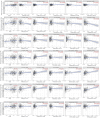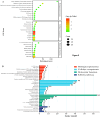Analysis of exportins expression unveils their prognostic significance in colon adenocarcinoma: insights from public databases
- PMID: 39776001
- PMCID: PMC11711428
- DOI: 10.1007/s12672-025-01748-4
Analysis of exportins expression unveils their prognostic significance in colon adenocarcinoma: insights from public databases
Abstract
Colon cancer remains a significant health burden globally, necessitating deeper investigation. Identification and targeting of prognostic markers can significantly improve the current therapeutic approaches for colon cancer. The differential nuclear transport (import and export) of cellular proteins, plays an important role in tumor progression. Exportins, critical mediators of nuclear export, have emerged as potential players in cancer pathogenesis. However, their precise roles and prognostic significance in colon adenocarcinoma remain elusive. This study was designed to comprehensively analyse the expression and prognostic significance of all seven exportins in Colon Adenocarcinoma (COAD) using the online public database. We used public databases UALCAN, C-Bio portal, Human Protein Atlas (HPA), and DAVID, to investigate exportins in COAD patients. Kaplan-Meier plotter, Gene ontology (GO), TIMER, STRING, and KEGG were used to analyse data and draw conclusions. Our observations showed a significant correlation of exportins expression with clinical parameters, used to predict a patient's prognosis in general, such as advancing tumor stage, overall/relapse-free survival, and immune cell infiltrations. Mutation analysis showed the presence of amplifications, missense mutations in XPO2 and XPO4, and deep deletions in XPO7 genes contributing to disease progression and patients survival. This study highlights the potential use of exportins as novel prognostic biomarkers and therapeutic targets for colon adenocarcinoma progression and management.
Keywords: Colon adenocarcinoma (COAD); Exportins; Expression; Mutation; Prognosis.
© 2025. The Author(s).
Conflict of interest statement
Declarations. Competing interests: The authors declare no competing interests.
Figures







Similar articles
-
Comprehensive bioinformatics analysis on exportins in lung adenocarcinoma and lung squamous cell carcinoma.J Thorac Dis. 2023 Apr 28;15(4):1872-1891. doi: 10.21037/jtd-23-228. Epub 2023 Apr 24. J Thorac Dis. 2023. PMID: 37197486 Free PMC article.
-
A Comprehensive Pan-Cancer Analysis Reveals Cyclin-Dependent Kinase Inhibitor 2A Gene as a Potential Diagnostic and Prognostic Biomarker in Colon Adenocarcinoma.Cureus. 2024 May 19;16(5):e60586. doi: 10.7759/cureus.60586. eCollection 2024 May. Cureus. 2024. PMID: 38894777 Free PMC article.
-
Pancancer analysis of NDUFA4L2 with focused role in tumor progression and metastasis of colon adenocarcinoma.Med Oncol. 2024 Oct 14;41(11):285. doi: 10.1007/s12032-024-02531-1. Med Oncol. 2024. PMID: 39402288
-
Peroxiredoxins and Immune Infiltrations in Colon Adenocarcinoma: Their Negative Correlations and Clinical Significances, an In Silico Analysis.J Cancer. 2020 Mar 4;11(11):3124-3143. doi: 10.7150/jca.38057. eCollection 2020. J Cancer. 2020. PMID: 32231717 Free PMC article.
-
An Intratumor Heterogeneity-Related Signature for Predicting Prognosis, Immune Landscape, and Chemotherapy Response in Colon Adenocarcinoma.Front Med (Lausanne). 2022 Jul 7;9:925661. doi: 10.3389/fmed.2022.925661. eCollection 2022. Front Med (Lausanne). 2022. PMID: 35872794 Free PMC article.
References
-
- Compton CC. Colorectal carcinoma: diagnostic, prognostic, and molecular features. Mod Pathol. 2003. 10.1097/01.MP.0000062859.46942.93. - PubMed
Grants and funding
LinkOut - more resources
Full Text Sources
